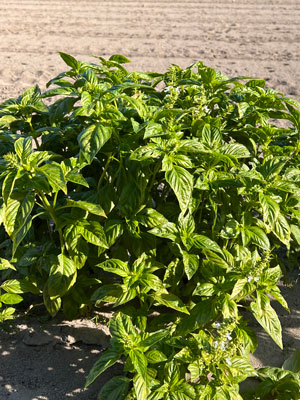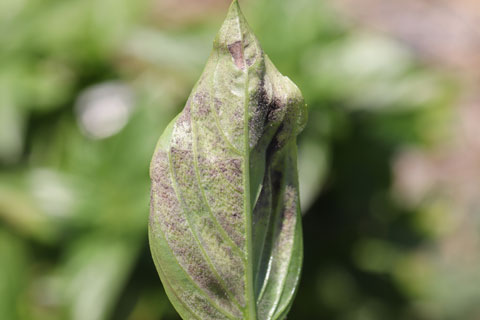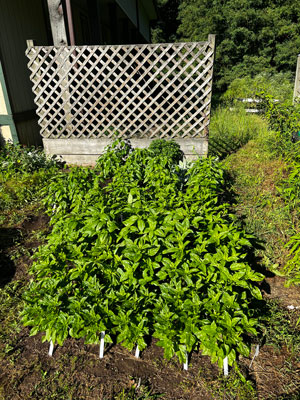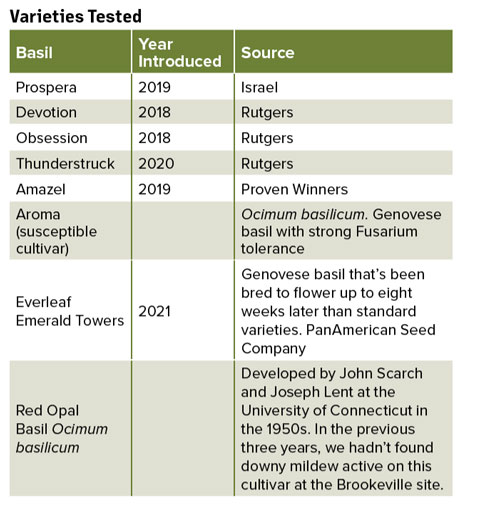5/1/2023
Multi-Year Basil Trials
Stanton Gill, David Clement, Alan Leslie, Ginny Rosenkranz & Sheena O’Donnell

For the last three years, we’ve been evaluating new basil cultivars (Ocimum basilicum) for resistance to downy mildew and we published the results in
GrowerTalks in 2021 and
Inside Grower in 2022. The best way to evaluate these new cultivars is to continue trials over multiple years where we experience different weather patterns, which influence the downy mildew infection. In 2022, we expanded the number of cultivars in our trial and continued to test the ones that were involved in our 2020 and 2021 trials.
Downy mildews infect plants in a wide range of temperatures, but infections are most severe from 59 to 68F (15 to 20C). Basil downy mildew, specific to this crop, continues to be the biggest challenge to basil production in America because it can spread rapidly and result in complete yield loss. We usually see this sort of weather pattern in Maryland in late August through September. In 2022, we had these conditions in September.
Italian sweet basil, which is the most popular for use in culinary dishes, is highly susceptible to this disease. It can be transmitted on seed and transplants. New infections can start from wind-blown spores moving northward from southern areas. As part of an IPM approach, the nursery industry needs to think long-term and this involves breeding and selecting resistant cultivars.
Pictured: Basil Devotion was one of four that produced the highest marketable yields with excellent resistance to downy mildew.
We continued our testing sites in multiple locations in Maryland, each with different temperature and humidity levels. We selected sites in north Central Maryland, (Carroll County), central Maryland (Howard County), southern Maryland (Charles County) and eastern Maryland (Wicomico County), with each site having different light and air circulation.
Warm, humid conditions at a site greatly influence the disease pressure and this can vary based on the location. The site in Westminster was at the top of a field in an open airy space. The sites in Howard at Central Maryland Research and Education Center, (CMREC) and Brookeville were in areas with 10 hours of direct sunlight, but surrounded by plant material that reduced air circulation. The length of direct sunlight was reduced to eight hours by September.
Getting started
Westminster and Brookeville sites: These sites were established on June 17, 2022. Each plot of raised beds made up of 8% leaf compost consisted of 10 plants of each cultivar. A trickle irrigation system with T-tape watered the plants. Transplants of Everleaf Emerald Towers, Obsession, Passion, Devotion, Thunderstruck, Aroma, Prospera and Red Opal Basil were established, and once the plants were 20- to 24-in. tall, we harvested the plants by cutting them to about 4 in. above the soil line. Each time the plants grew back to 20- to 24-in. tall another harvest was taken and recorded. The foliage was examined and symptoms of downy mildew were noted on a 14-day interval.
Finksburg: At this site, six plants of each cultivar Devotion, Passion, Thunderstruck, Aroma, Obsession and Everleaf Emerald Towers were planted in containers on a deck with full day sun.
CMREC: At this site, the plants were placed in topsoil with 2% organic material on July 5. No trickle irrigation was established at this site, but hand watering was carried out during dry/hot spells. Space was limited, so this site only had five plants per cultivar. For this reason, spacing between each plant was also shorter than at other sites. Cultivars Obsession, Everleaf Emerald Towers, Passion, Devotion, Thunderstruck, Aroma and Amazel were transplanted to this site.
 Pictured: Downy mildew spores on the underside of a basil leaf.
Pictured: Downy mildew spores on the underside of a basil leaf.
Charles County: The cultivars tested at this location were Devotion, Passion, Thunderstruck, Aroma, Obsession and Everleaf Emerald Towers. At this site, there were four reps planted with six plants in each plot. Plants were put in the ground on June 16 and dead plants were replaced on June 21. The plots were fitted with 3-ft. black plastic in flat rows with 5 ft. between each row and a single line of drip tape. There was one harvest at this site. Harvest included cutting plants down to about 3 in. above the soil line and then weighing yields. At this location, leaves with DM symptoms were incubated to ensure downy mildew was the reason for the symptoms.
Salisbury: Six plants of each cultivar Devotion, Passion, Thunderstruck, Aroma, Obsession and Everleaf Emerald Towers were planted. Three Everleaf Emerald Towers succumbed to downy mildew immediately after planting, and the remaining were evaluated for symptoms on September 15 and September 29.
Evaluation
CMREC: At this site in Howard County, harvest occurred on August 18, with four to seven stems cut down to 4 in. above the soil line per plant. For the stem to count as saleable it had to be at least 6-in. long. The only exception to this four- to seven-stem average was Everleaf Emerald Towers, which only yielded an average of two stems per plant, but internodal space was very short and the total number of leaves at harvest was comparable to the larger cultivars with four to seven stems per plant. Total harvest was weighed and Everleaf Emerald Towers’ shorter stems were included for this purpose because of the high number of intact leaves on the short stems. The plants did not grow back enough to carry out a second harvest before the cold temperatures ended the trial.
At the time of harvest (August 18), only one plant each of two cultivars (Everleaf Emerald Towers and Obsession) were showing symptoms of DM. Less than one month later on September 8, all plants of all cultivars were showing symptoms. Aroma never put on any new growth after the first harvest and heavy weed competition took this cultivar out shortly after. The remaining plants only grew back to be at most 6-in. tall and were mostly dead or defoliated by the end of September. There was one early frost in September that did some damage on the plants and they never leafed out again after that. By the end of the trial (September 8), the most heavily infected cultivars were Everleaf Emerald Towers and Aroma.
Charles County: In Charles County, harvest occurred on August 18 and mass was recorded for each plot. All plots of Aroma, three-fourths of the plots of Everleaf Emerald Towers and one plot of Devotion yielded unmarketable stems. Obsession performed the best at this location, with no visible symptoms of downy mildew in any of the reps and the second-highest mass harvested. Passion is also worthy of an honorable mention because it was mostly disease-free and had the third-highest mass yield. Everleaf Emerald Towers not only yielded about 75% unmarketable stems, but also had the lowest mass harvested at only 3.9 pounds for six plants.
Salisbury: In Salisbury, plants were evaluated for resistance on September 15 and September 29. Everleaf Emerald Towers and Aroma had poor resistance to DM, Obsession and Thunderstruck had good resistance, and Devotion and Passion had good to excellent resistance.
Westminster and Brookeville: Harvest at these sites was every two weeks in July, August and mid-September, cutting stems to 4 in. from the soil line. Bunches varied from four to seven stems per plant at each harvest. At farm markets, these bunches could easily fetch $5 to $6 per bunch. The first harvest occurred July 15, 2022, and continued on two-week intervals though mid-September.
 Pictured: A basil plot at the Central Maryland Research and Education Center in Howard County, Maryland.
Pictured: A basil plot at the Central Maryland Research and Education Center in Howard County, Maryland.
In mid-September, as temperatures cooled, harvest was extended to every four weeks. By early October the cultivars Devotion, Obsession, Prospera, Passion and Thunderstruck all started to produce flowers. Everleaf Emerald Towers started to produce flower heads in late September. The plants stopped producing marketable foliage by early September. We continued to harvest all of the cultivars until October 29, 2022, at the Westminster site.
Downy mildew was detected on September 11 on Aroma basil with 10% of foliage infected. By September 23, all of the Aroma plants were dead. Passion had under 5% of the foliage infected with downy mildew on September 11, but the plants continued to grow and produce foliage
At the Brookeville site, on September 18 we detected downy mildew on Aroma, lemon basil and Passion. The Aroma and lemon basil plants were thoroughly covered in downy mildew within two weeks. Passion showed 20% to 30% of the foliage infected. Though the plants continued to grow, they didn’t have marketable foliage. Prospera, Obsession, Devotion, Thunderstruck and Opal all were free of downy mildew until heavy frost in early November ended the trial.
Finksburg: The first symptoms of downy mildew appeared on Aroma and Everleaf Emerald Towers on August 19. The disease progressed rapidly on these two cultivars and by September 9 all had severe symptoms. The remaining Devotion, Passion, Thunderstruck and Obsession cultivars remained free of disease for the duration of the trial.

Final summary
Overall, Devotion, Passion, Amazel and Prospera showed the highest resistance. Thunderstruck and Obsession showed moderate resistance, but still had symptoms. Everleaf Emerald Towers showed very little resistance, if any, and also had the lowest yields.
In Westminster and Brookeville, Prospera, Obsession, Devotion and Thunderstruck didn’t show any symptoms throughout the season. Passion continued to grow, but the product was not marketable due to heavy infection.
At CMREC, all cultivars besides Aroma performed well until late in the season, when all varieties were infected. By the third week of September almost all plants had symptoms. Amazel had the highest yield by far, with no visible symptoms of DM. Devotion had the next-highest yield, followed by Passion and then Thunderstruck. Aroma continued to grow, but showed symptoms of DM the earliest.
In Salisbury and Charles County, Devotion, Obsession and Passion performed the best. In Finksburg, Thunderstruck, Devotion, Obsession and Passion did well in containers.
Based on our trials Devotion, Passion, Amazel or Prospera produce the highest marketable yields and have the best resistance to downy mildew.
Trials in 2023 should continue to test resistant basil varieties in a new year with new weather patterns. There are also new Prospera varieties available now, which should be included. For example, we would like to include Prospera Compact, Prospera Red (red-leafed variety) and Prospera Italian Large Leaf.
Stanton Gill is an Extension Specialist in IPM and Entomology at University of Maryland Extension; David Clement is an Extension Specialist in Plant Pathology at University of Maryland Extension; Alan Leslie is an Extension Educator at University of Maryland Extension Charles County; Ginny Rosenkranz is an Extension Educator at University of Maryland Extension Wicomico County; and Sheena O’Donnell is a Technician at CMREC at University of Maryland Extension. If you or someone you know is a seed supplier and would like to work with us using new downy mildew-resistant basil varieties, please contact Stanton Gill at sgill@umd.edu.